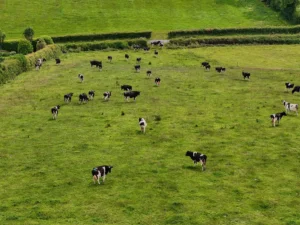
Cattle, greenhouse gases and the case for better methane metrics
Why the global warming potential of methane emissions from cattle production needs a closer look
Each year, a single cow will belch about 220 pounds of methane, a potent greenhouse gas that contributes to climate change.
But why do cows produce methane?
Methane is produced by the microbes that live in cows’ digestive systems. With the help of these microbes, cows can digest tough, fibrous plant materials such as grass, stalks and husks. These materials have plenty of energy stored up in the form of complex carbohydrates — but humans can’t digest them. We need cows to “upcycle” them instead, digesting them and turning them into meat and milk that our bodies need.
That’s a win-win for both cows and humans — except for the methane that’s produced as a natural byproduct of the process and expelled into the atmosphere. Unlike the burning of fossil fuels, these emissions are a naturally occurring process that’s been happening safely for as long as there have been cows. In fact, it’s part of an efficient system called the biogenic carbon cycle, which benefits plants, animals, humans and soil.
So, how and why do a cow’s gut microbes produce methane in the first place? And what role does methane actually play in the science of climate change?
Cows, like other ruminant animals, have multiple stomach compartments. The one that plays the biggest role here is the first and largest: the rumen. When fibrous plant matter is eaten by the cow and reaches the rumen, trillions of helpful microbes — including bacteria, fungi and protozoa — work together to help the cow digest it. This process is helped along by cud chewing, during which the cow repeatedly regurgitates, re-chews and re-swallows her food. (Sounds gross to us, but cows love it. In fact, they spend most of the day chewing their cud!) As the microbes continue to break down complex carbohydrates into simpler molecules, volatile fatty acids (VFAs), which are then produced and absorbed by the cow as a vital energy source.
However, this process also produces hydrogen. While hydrogen is pretty handy in other ways —we need water, after all — it can be harmful if allowed to build up in a cow’s rumen. To prevent this, microbes called methanogens combine the hydrogen with carbon dioxide (CO2), another byproduct of fermentation. This produces methane, which is then released by the cow through belching or in the manure.
Methane is a highly potent greenhouse gas, roughly 25 times more powerful than CO2 in terms of heat-trapping ability. However, it remains in the atmosphere for a much shorter period — about 12 years, as opposed to 300–1,000 years for CO2. It then breaks down into smaller amounts of CO2 and water, which are converted by plants into more energy for cows; that’s the biogenic carbon cycle we mentioned earlier. Because of this cycle, methane from cows doesn’t keep building up in the atmosphere for centuries, as CO2 from fossil fuels does.
Of course, methane does still contribute to climate change. Methane from cows accounts for about 5 to 7% of global greenhouse gas emissions, according to the Intergovernmental Panel on Climate Change. (Fossil fuels account for 75–78%.) But methane’s shorter lifespan also means that reducing methane emissions can have an almost immediate impact on slowing global warming. That’s why many global initiatives aim to reduce methane emissions as part of the broader climate solution. For instance, more than 150 countries have signed the Global Methane Pledge, committing to reducing methane emissions by 30% by 2030.
But how do we reduce methane levels without reducing our production of beef and dairy products, which we need increasingly more of to meet the protein requirements of an ever-growing human population?
It’s science to the rescue! Thanks to innovative, practical, research-based solutions — including those outlined below — cattle producers are already making significant progress in reducing methane emissions.
One of the simplest ways to reduce methane emissions is to modify what cows eat. Fats, in particular, can lower the production of methane without negatively affecting the digestive process. Also, balancing fibrous plants in the diet with more digestible forages, such as grains, can keep the upcycling going while reducing hydrogen production, which translates to lower methane levels.
In fact, research has shown that simply boosting the levels of fats and grains in a cow’s diet can reduce its methane emissions by up to 20%.
Certain feed additives can alter the microbial population in the rumen in a way that allows the cow to digest its feed without producing as much methane.
Adding small amounts of the microalgae Asparagopsis to cattle feed, for instance, has been shown to reduce methane emissions by up to 80% by inhibiting the enzymes used by methanogens to produce methane. Certain types of yeast, such as Saccharomyces cerevisiae, can also reduce methane production while boosting gut health.
Even with these changes in feed types and additives, methane will be produced. What if we could capture that methane before it escapes into the atmosphere, or pull it out of the atmosphere and sequester it safely?
We’re already seeing major successes in such attempts by way of methanotrophs, which are bacteria that consume methane as their energy source, converting it into CO2 and water. These bacteria are naturally abundant in certain ecosystems such as wetlands, forest soils and grasslands. Since they are more active in well-aerated soils with a good balance of moisture and organic matter, farming practices like reduced tillage, crop rotation and agroforestry can increase their numbers and their ability to convert methane and keep it out of the atmosphere. These practices help the environment in many other ways too.
Some scientists are developing devices that capture methane as it is expelled by the cow. One such device would be installed in barns. Another is a mask the cow can wear, containing a catalyst that would turn methane into CO2 and water right away, keeping it in the biogenic carbon cycle but skipping the step where it spends years in the atmosphere.
After methane is converted to CO2 and water, the CO2 can then be captured, or “sequestered,” in the soil, if that soil is healthy. Interestingly, the ideal soil conditions for carbon sequestration can be created by the kind of common-sense cattle management techniques and organic materials that cattle farmers have used for millennia, and that many cattle smallholders still use. For instance, grazing cattle naturally on-pasture can encourage root growth and enrich the soil so that it can capture more carbon than the cows grazing on it emit, creating a net-carbon sink.
These management techniques are also good for the environment in many other ways.
Extra methane is produced when manure breaks down in an anaerobic environment — or, one without oxygen. By regularly aerating cow manure, farms can reduce methane levels.
Even better, many farms are installing anaerobic digesters, which convert manure into biogas. This biogas, composed of roughly 60% methane and 40% CO₂, can be captured by the digester and then used as a renewable energy source. Farms are increasingly using biogas to power their vehicles and heat their homes. Some even produce enough energy to supply nearby towns with electricity!
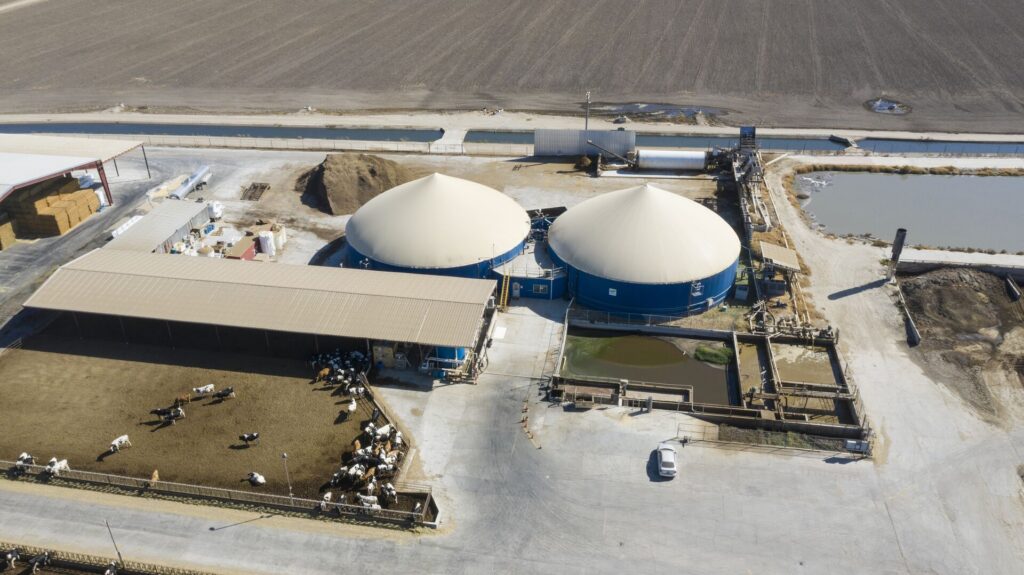
Some cows just naturally produce less methane, due to differences in their gut microbiomes or how they digest food. Just as cows can be bred for traits like milk production, they can be bred for lower methane production. Through selective breeding, scientists and farmers can reduce emissions over time with minimal impact on health or productivity.
While methane from cattle is a significant contributor to agricultural greenhouse gas emissions, people from across the agriculture industry — from farmers and ranchers to scientists, regulatory agencies, nutritionists and feed producers — are stepping up to the challenge of reducing methane emissions.
Through the use of alternate feed types, innovative supplements, new methane conversion technologies, improved manure management, smart pasturing techniques and even selective breeding, cattle farming is already building a future of both abundance and sustainability.
Dig deeper: The CLEAR Center at the University of California, Davis, and many other research centers around the world are working on solutions to reduce methane production in cattle without compromising animal health and performance. Click here to learn more.

Why the global warming potential of methane emissions from cattle production needs a closer look
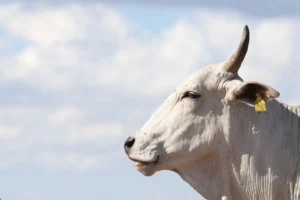
At COP30, the world’s eyes are on Brazil, and the cattle ranchers leading a global transformation.
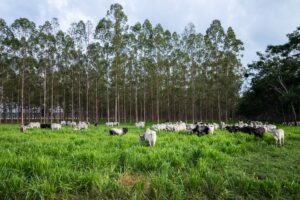
Restoring 40 million hectares of pasture could feed billions and ease pressure on the Amazon. Is the world paying attention?
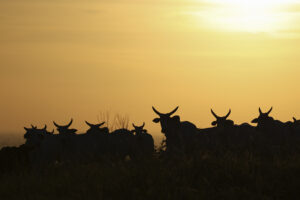
New mini-doc explores deforestation, food security and the Brazilian cattle sector’s path to a more sustainable future

Mention Brazilian beef, and you’re likely to spark discussion about familiar themes: deforestation, emissions and blame. What do we find when we dig deeper? Here are the answers to five top questions about Brazil’s role in protecting the Amazon and feeding the world.
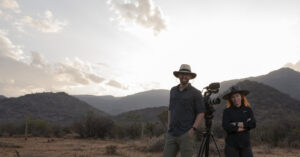
From science to the big screen: Discover how a single question grew into a global journey.
As climate change intensifies and the world’s population continues to grow, the pressure on our global food production system mounts. You can play an active role in shaping a more sustainable planet for future generations. Fill out the form below to learn more about how you can partner with us.
Receive notifications about the release date, new online content and how you can get involved